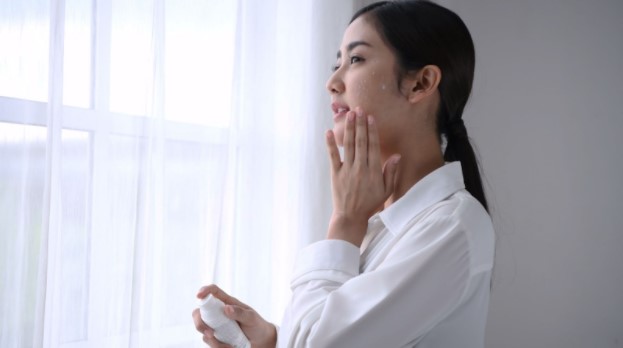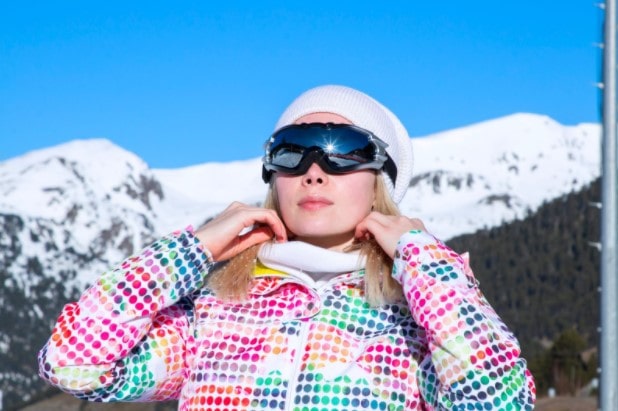Why is sunscreen use important all year?
Table of Contents
Using sunscreen is a standard part of our lives each summer. Many of us apply sunscreen to protect ourselves from harmful UV rays from the beach to the pool. Though this summertime habit is terrific, protecting yourself from UV exposure shouldn’t end there. In fact, you should be wearing sunscreen year-round. Read on for answers to common questions surrounding sunscreen use all year long.

What are UV rays?
Ultraviolet rays are damaging rays secondary to the sun or are made artificially (like those found in tanning beds). If we’re getting them from the sun, they’re penetrating through the ozone layer, exposing us to dangerous levels of UV radiation. It’s that radiation, coming from those UV rays, that damages your skin. There are three different types of UV rays: UVA, UVB, and UVC. The ozone layer mainly filters out UVC; UVA and UVB are not. So that’s why when we talk about sunscreens, we talk about UVA and UVB rays, specifically. What will those rays do to your skin? UV rays can penetrate deep into our skin and cause genetic changes, which ultimately lead to skin cancer. UVB classically causes burn (think B for burning). Burning is bad. That will cause skin cancers in the future. UVA ages our skin. It causes significant aging and can also contribute to the development of skin cancers, though to a lesser degree than UVB rays. This is why it’s essential to wear sunscreen year-round: these UVA and UVB rays don’t only appear in the sunny summer weather. You can be exposed to them any time of year, whether in direct sun or not; they can penetrate through clouds and snow, even windows. So whenever there is any type of direct connection to the outdoors, through a window inside your home or car or whatever it be, you can have UV exposure.
What about tanning beds?
Tanning beds directly expose a person to UV rays. Most of the time, beds feature broad-spectrum UV light (meaning both UVA and UVB rays are present). Additionally, in a tanning bed, you are getting exposure to these rays at an intensity that is many times that of the sun. They are the same broad spectrum waves that we see from the sun but are intensified because we’re so close to them in a tanning bed. That’s why tanning beds are so dangerous. Consider how many miles away the sun is from us. Even that far away, exposure to the sun’s UV rays can age and burn our skin. Now consider that, in a tanning bed, we take those same rays and, rather than expose ourselves to a source miles away, we put ourselves right next to the source. It’s now much easier to imagine the amount of damage that direct, close exposure is doing and how it can cause direct DNA damage to your skin.
Is it true computer screens can expose a person to UV rays, too?
No. Ultraviolet (UV) light and the blue light we’re getting from our phones and computer screens are different. They are wavelengths of different spectrums and affect our skin differently; that blue light isn’t known to damage our skin in the same way as UV and so isn’t going to contribute to skin cancers or premature aging.
Why do I need sunscreen for skin protection?
Sunscreen is imperative for us because those UV rays induce changes to our DNA, which can lead to skin cancers. What sunscreen does is prevent those changes from occurring and, as a result, protect us from developing skin cancer in the future or experiencing premature aging now.
What if I’m only outside for a little bit?
Be reasonable. If you’re running out to grab something from your car and you’re coming right back in, you don’t necessarily need to lather on sunscreen for five minutes beforehand. However, if there’s an opportunity for you to be outside much longer, even if you’re in the shade, then yes, apply sunscreen. In the same way that you can be exposed even on a cloudy day, you can be exposed in the shade of a tree. So if you don’t have a UV protectant layer on (whether that be clothing or sunscreen), you’re not getting that UV protection.
What if I have more melanin in my skin?
I often see people that think that because they have darker skin, they don’t need as much protection since the melanin in their skin is already doing that for them. While it is true that’s what melanin is for, and that having more melanin in your skin does naturally yield more protection from UV rays, it does not mean that additional protection isn’t needed. Every time our skin darkens from sun exposure, DNA changes happen at a molecular level. That happens regardless of skin color. Darker-skinned individuals may be at lower risk for skin cancer, but they can still get it, so they definitely need to be protecting themselves with sunscreen.

Okay. I need sunscreen, but do I need it all year?
We tend to think that when it’s cold, we don’t need sunscreen quite as much because we don’t feel hot. We don’t feel like we’re burning in the sun. In fact, we like to feel that warmth when it’s cold; however, the UV rays are still there. They don’t change based on weather or temperature. This is especially important when there’s snow on the ground because the UV rays reflect off of the snow. Because of this reflection, you can get sunburns in the winter. So if you’re out skiing, sled riding, or otherwise enjoying the winter outdoors, you really should make sure that all of your exposed areas (typically your face and hands) are covered with a sun protective layer to minimize burning.
Do I need to use the same kind of sunscreen I do at the beach in winter?
Remember, the best sunscreens are the ones you’re going to use. If you have a sunscreen that you like to use on the beach, you like to use it for a reason. So long as it’s 30 SPF (sun protection factor) or greater, I’ll recommend that you use that in the winter, too.
What should I be looking for in a sunscreen?
First, it helps to understand that there are two very different kinds of sunscreens. The first is physical blockers. You put these on your skin, and those UV rays bounce right off. I liken them to wearing sun-protective clothing. Just as wearing a shirt that has UV protection in it prevents UV rays from penetrating your skin, physical blockers (which contain zinc oxide or titanium oxide) basically coat the outer levels of your skin, preventing the sun from penetrating at all. So physical blockers provide a direct level of protection. The second kind is chemical blockers. Chemical sunscreens, which contain oxybenzone and avobenzone, work very differently. When applied correctly, they are rubbed into the skin and absorbed into the top layers of our skin. The sun still penetrates the skin, but the chemical blockers target the UV rays as they make those DNA or genetic changes that lead to skin cancer. They protect our skin by helping minimize the damage caused by the UV rays at that time. Because the sun has already penetrated the skin with chemical blockers, we as dermatologists usually recommend using a physical blocker with a chemical blocker. So when looking for a sunscreen, make sure there’s a physical blocker in it (like titanium dioxide or zinc oxide) and that the sunscreen provides broad-spectrum protection (meaning that it will block both UVA and UVB rays).
Are there better brands than others?
Yes. There are two brands I commonly recommend. CeraVe products are great skincare products in general. This applies to their sunscreens, too. They’ve done a lot of research over the years, yielding effective, quality sunscreens that users like. CeraVe’s products tend to go on nicely, don’t leave white residues, and, most importantly, are protective. The other brand is called La Roche-Posay. It’s a lesser-known brand from France that has powerful, unique technology in their sunscreen that no other brand in the world is utilizing at this point. Their sunscreens not only work to protect your skin from the UV rays in the moment but also reverse some of the damage that has been done previously while also helping to prevent damage in the future. The technology they’re putting into their sunscreens, achieved as a result of a lot of research, is second to none.
Are there some sunscreens that are better for different parts of the body?
Because you may be putting makeup or other products on top of it, I sometimes make different recommendations for the sunscreens used on your face than those used on your body. For example, most people don’t want thick, heavy sunscreens on their faces, so I might recommend a sunscreen fluid. These fluids are really thin, go on really nicely, and protect your skin (typically through the use of physical blockers). Additionally, the fluids don’t cake up underneath your makeup because of their texture. When using them, you can continue to live your life like normal, which is crucial because it means you’re more likely to continue using the sunscreen and protecting your skin daily. For the body, I recommend lotions rather than thick creams because lotions are thinner in texture, spread better, and are easier to apply. Regardless of where (face or body) you are applying sunscreen, and whether or not you are using lotions, creams, fluids, or sprays, the application is key: you have to rub them in! Because they need to get to the first or second level of the skin, where they can really do their work protecting you. You’ve got to rub them in. If you’re not rubbing them in, they’re not doing their job.

What if my makeup already has SPF?
When looking at makeup that contains SPF, it’s essential to consider how you are using the makeup. Most of the time, you’re not wearing makeup to the beach or to the pool, where you’re going to be directly exposed to heavy-hitting sun and UV rays. In those cases, the SPF of your makeup is irrelevant. However, if there are times when you’re out and about, and you need to have sunscreen on, makeup can do a decent job of protecting your skin from UV rays because of the SPF in it. That said, the next thing to ask yourself is how frequently are you reapplying your makeup? The answer is usually not often (if at all); however, sunscreen needs to be reapplied repeatedly. When you’re out in direct sunlight, applying it once isn’t enough. You have to reapply consistently to ensure you’re protecting yourself at all times. It does not take long for sun exposure to yield those DNA changes, which can ultimately lead to skin cancer. If you’re relying on the SPF in your makeup to protect you and aren’t reapplying that, you’re not getting protection. If wearing makeup is a must, try using a tinted sunscreen. You can apply it and keep reapplying it throughout the day without messing up your makeup. In short, sunscreen is not just for summer. Use it all year long to keep your skin healthy and protect it from the harmful UV rays that cause premature aging and skin cancers. Have specific concerns about sun exposure? Schedule an appointment with Dermatology, Surgery, and Cosmetics of Northeast Ohio today to speak to one of our dermatologists about the best ways to protect your skin from harmful UV radiation.
